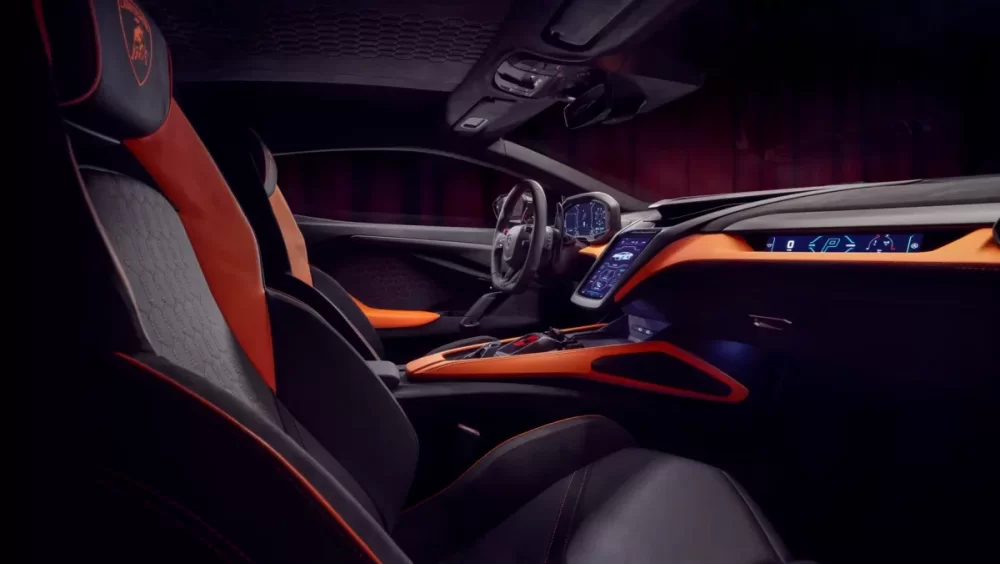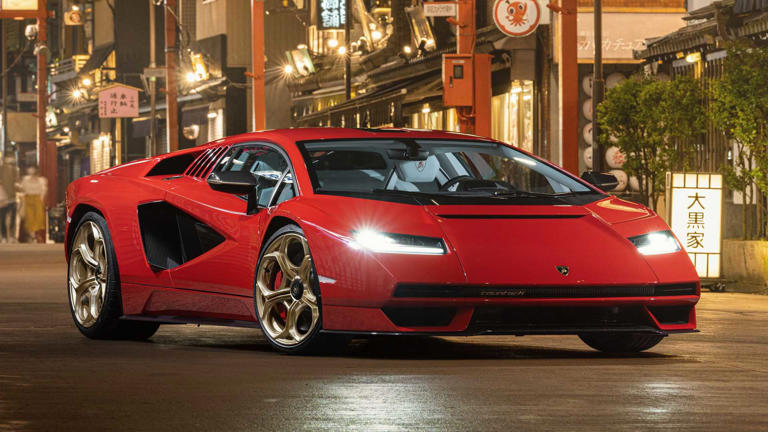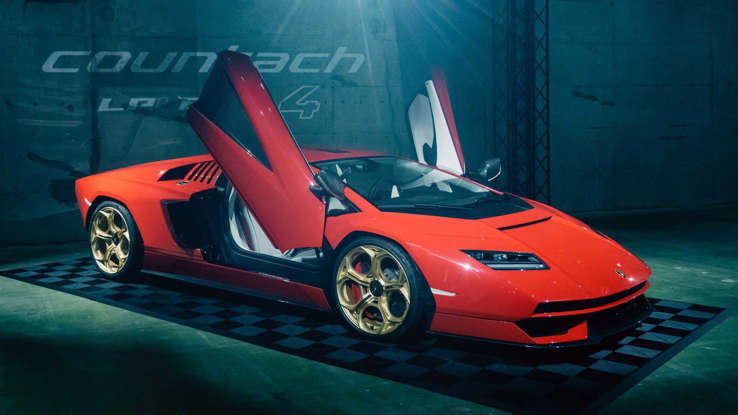Search the Community
Showing results for 'lamborghini' in topics.
-

Motor insurer AIG stops insuring McLarens driven to Malaysia
ER-3682 replied to kobayashiGT's topic in General Car Discussion
Italian Ferrari also not that good either,except Modern Lamborghini,because using German VW/Audi Parts... -

Motor insurer AIG stops insuring McLarens driven to Malaysia
ER-3682 replied to kobayashiGT's topic in General Car Discussion
Good Drivers drive Ferrari & Lamborghini.? -
It's the new Lamborghini SUV! Meet the Urus https://www.topgear.com/car-news/suvs/its-new-lamborghini-suv-meet-urus Lambo's long-awaited return to the SUV sector is here. Full details on 641bhp Urus here The Urus is Lamborghini’s long-awaited re-entrance into the SUV market. It’s also the perfect representation of its 55-year journey from seller of mad things with an allergy to ergonomics, to an ultra-modern supercar manufacturer with the quality, reliability and business sense of Audi. Few would argue the latter is a bad thing when it spawns a family of supercars that you can actually see out of and start on the button every time… but the big fat question here is, is a spacious, high-riding, five-seater family SUV pushing the Germanic sensibleness too far? Let’s start with the way it looks. No doubt you made your mind up within seconds of seeing it, but hopefully we can agree on one thing: of the Porsche Cayenne, Bentley Bentayga and Audi Q7 bunch with which it shares its steel and aluminium MLB platform, it’s not pug-ugly like the Bentley, and has more presence than the other two put together. In the interim five-and-a-half years since we saw the Urus concept, it’s become a little larger, rounder and wider of arse, but the overall shape is surprisingly faithful. There’s the same arrowhead bonnet shut line, but beneath that there’s a lot more going on. Layer upon layer of mesh, intakes and splitters with a cycloptic sensor housing parked in the middle of it. You’ll notice the yellow car here is maximum jazzy – fortunately, more subdued specs, like the grey car with mostly blacked-out elements, are available. Around the back, the concept’s tailpipes have dropped, but the small rear windscreen and full-width tail-light have survived. From this angle, perhaps more so than the front, it’s instantly a Lamborghini. But the Urus’s real trick is to combine a downward-sloping, BMW X6-esque roofline, which keeps things pinched and muscular around the rear wheelarch, with masses of interior space. We’re talking six-footer behind a six-footer with a good chunk of leg- and headroom to spare. It also has a 600-litre boot – enough for a grown man to climb in on all fours and do a convincing impression of a large dog. Big wheels (21-inch as standard, up to 23-inch if you must) and edgier styling than its rivals isn’t enough to earn the Lamborghini badge. For that, it must possess a vicious turn of speed, which is where 641bhp, 627lb ft of torque (available from 2,250rpm), 0–62mph in 3.6 seconds and 190mph flat out come into play. Before you start Googling furiously, the 707bhp Jeep Grand Cherokee Trackhawk also takes 3.6secs, but that’s from 0-60mph, and it trails by 10mph at the top end. That makes the 2.2-tonne Urus officially the fastest SUV out there. Frankly, we’d be perturbed if it wasn’t. Where mild perturbing might occur is under the bonnet. You won’t find a highly strung, naturally aspirated V10 or V12 on loan from the Huracán or Aventador, but a version of the 4.0-litre twin-turbo V8 from the Bentley Continental GT and Audi RS6, connected to an eight-speed auto and redlining at 6,800rpm. If you can get over the fact that it’s more likely to woofle and rumble than bark and shriek, it’s actually a far better fit for an off-roader – offering more torque at lower rpm. And yes, you can take your Urus off-road should you wish. The V8’s other trick is being the most fuel-efficient engine ever in a Lamborghini (22.2mpg, 290g/km CO2) thanks in part to a cylinder-deactivation system that works below 3,000rpm and gives you 173lb ft to work with. That’s right, tickle the throttle and you’ll find yourself driving a four-cylinder Lamborghini with less torque than a diesel Ford Fiesta. But let’s not be churlish. It’s a familiar and brilliant engine ably supported by all the weight-cloaking chassis aids Lambo could lay its hands on. Firstly, the standard torque split is 40/60 front/rear (up to 70 per cent can be sent to the front, or 87 per cent to the rear as and when the conditions dictate), with active torque-vectoring from front to back axles, and between the rear tyres, via centre and rear differentials. Long story short: on loose surfaces, it’ll power oversteer, but on tarmac it should stick. And stop, thanks to standard carbon-ceramic brakes – 440mm rotors at the front, 370mm at the rear – currently the largest on any production car. Adaptive dampers work alongside an electromechanical active roll stabilisation system. It’s basically the same set-up that’s already left us stunned in the Bentayga and SQ7 – compliant in a straight line, magically flat in the corners. And then there’s the performance tech du jour, four-wheel steering, which twists the rear tyres by plus or minus three degrees, effectively shortening the wheelbase by 600mm at low speeds (by turning in the opposite direction to the fronts), or lengthening it by 600mm at higher speeds (by turning in parallel to the fronts). Getting the thing started, moving and in your mode of choice is done via a bank of industrial-sized levers. In the centre, the start button lurks beneath a flip-up cover, itself in the shadow of a palm-sized gear-selector. To the left of that is your Anima lever, used to toggle through the four standard modes: Strada, Sport, Corsa and Neve (snow), plus two optional modes: Terra (off-road) and Sabbia (sand) if you genuinely want to get grubby. Each tweaks the diffs, sound, steering, suspension, throttle and gearbox response, and raises (Neve, Terra, Sabbia) or lowers (Sport, Corsa) the air suspension accordingly. Alternatively, you can set your ideal combo of ride, steering and powertrain with the Ego switch on the right. Assume the driving position and, although physically high, you feel low, snuggled below the shoulder line. WE set about looking for some ergonomic nightmare – a lorry-sized blind spot, tortuous seats, razor-sharp trim gaps – alas, there are none to be found. The skin of this interior is very much Lamborghini – all hexagons and Alcantara – but the hardware and execution is pure Audi. Right down to the twin screen (triple if you count the instrument cluster) infotainment system lifted wholesale from the new A8. Unusually then, this is a Lamborghini, tech-wise, allowed to sit above its Bentley and Audi cousins. An indication of just how crucial this car is for the long-term health of the company, and how badly the VW Group wants it to succeed. Inside and out, it’s an impressive engineering achievement, especially from a relative minnow that sold just under 3,500 cars in 2016, although Lamborghini hopes to double that with the £165,000 Urus by 2019. Picking over the spec sheet and poking around the interior is all well and good, but this is a Lamborghini and therefore needs some Lambo DNA in its bones. Can it really be both – a family van with the heart of supercar?
- 23 replies
-
- 3
-

-
- lamborghini
- urus
-
(and 5 more)
Tagged with:
-
Source: https://www.cnet.com/roadshow/news/lanzador-concept-previews-first-all-electric-lamborghini/ Following the debut of its upcoming Revuelto plug-in hybrid super sports car, Lamborghini takes another step into the electric age, unveiling a concept "ultra GT car" that will eventually become its first fully electric vehicle. Meet the Lamborghini Lanzador. The Lanzador is long -- nearly 197 inches from bumper to bumper -- and large, a 2+2 coupe that blends inspiration from the everyday-driveable Urus SUV and the super-sports-coupe-on-stilts Huracan Sterrato. The result is what Lambo is calling an ultra GT that matches the performance of a sports car with the space, comfort and silent operation of a full-size luxury cruiser. Meanwhile, the elevated ride height and liftback configuration add a bit of active lifestyle utility flavor to this multitool of a concept vehicle. Stop me if you've heard this one before. I spoke with Lamborghini's Design Lead Mitja Borkert, who pointed out the Lanzador's use of key Lamborghini design elements -- the squared-off shoulders and greenhouse, the single sweeping roofline that flows from nose to tail and the cab-forward proportions. The Lanzador's large size and tall ride height is in some part due to the realities of designing around an electric battery pack and the ultra GT's mission as a comfortable, luxurious commuter, but even so the automaker was able to create a surprisingly low seating position and, hopefully, a driving experience evocative of the Revuelto. More than a megawatt Behind the Lanzador's genre-bending design is an incredibly flexible and customizable network of performance systems. At the concept's debut, CEO Stephan Winkelmann hinted that we should expect more than a megawatt (over 1,341 horsepower) output through wheels via a full-electric all-wheel drive system. Lambo CTO Rouven Mohr later told me in an interview that the Lanzador will likely stick with two electric motors -- rather than three or more -- which the brand's engineers feel is a sweet spot for power, packaging, weight and driving feel. Beneath the cabin lives an advanced battery pack that promises high performance and "long range." Lambo isn't disclosing range targets or capacity at this point in development, but Mohr says to expect battery tech and chemistry shared with other members of the Volkswagen Group. Transform and roll out I was most interested in the Lanzador's wild aerodynamics. Mohr explains that the mission of the Lanzador as a grand tourer that drivers will live with every day means you can't just whack a big wing on the back like the Huracan STO, so his engineers went about hiding one of the most advanced active aerodynamics systems I've ever seen inside and underneath the EV's silhouette. Motorized aerodynamic elements in the bumpers, front splitter and rear diffuser deploy in an instant to increase downforce as necessary. Louvers hidden under the hood draw high-pressure air from the wheel arches to reduce drag. Carbon-fiber strakes rise from either side of the rear skylight to guide air over or through the spoiler integrated into the rear decklid. Even the headlamps feature air guides that flow air over and through even more aerodynamic elements hidden on or under the hood. Watching the Lanzador change from low-drag cruiser to high-downforce performer -- aero bits deploying and the suspension hunkering down -- is a bit like watching a Transformer do its thing, but Mohr was most proud of the next generation of Lamborghini's Integrated Control software. AI-powered performance "In the future, the hardware will not be the game changer," Mohr states. "You need a certain level of hardware, but the game changer is the Integrated Control system, because this defines how the car is reacting. In our first electric car, we go to [software version] 3.0, which means we incorporate all the active systems, including the active aerodynamics, and we have also much more possibilities in the steering of the electronic model and this will allow us to have an outstanding driving behavior." Lamborghini envisions that this Integrated Control version 3.0 will also integrate machine learning and artificial intelligence tech to adapt to the driver and the driving conditions, for example, predicting grip based on information gathered from the sensors and tweaking the electric motors' torque distribution or noticing the driver's behavior on a long straight stretch of highway and adjusting the aerodynamics and suspension for increased range and comfort. The Lanzador will also see an increased focus on driver aid tech with piloted and automated driving systems slated to make an appearance. Inside, the Lanzador's double-cockpit cabin is framed by a large center console that echoes the Y-shaped motif found in the headlamps. Dual screens rise from the dashboard at startup like the Countach's classic pop-up headlamps, presenting the driver with a digital instrument cluster and the front passenger (or co-pilot) with infotainment information. The steering wheel and center console feature unique physical controllers with a sci-fi design. The entire cabin makes use of exotic eco-friendly materials, including recycled carbon fiber suspended in bioresin, sustainably harvested Merino wool and 3D-printed recycled foam. Meanwhile, the flexible second row boasts room for two passengers or outdoor gear like a bike or surfboard beneath the Lanzador's transparent roof. The future of Lamborghini The production version of the Lamborghini Lanzador is slated to arrive in 2028, giving the automaker five years to finalize all of the details. In the meantime, expect a refreshed version of the Urus to arrive within the next year. It'll be sporting a new plug-in hybrid powertrain for the next few years before also making the jump to full electric with a completely new generation slated to join the Lanzador in 2029.
-
Dunno, but the noisy cars I see usually are cars that are not very good in performance and the drivers want people take a 2nd look at them and thinking that their cars are super cars like Lamborghini or Ferrari. In fact, usually are the Lancers acting as Evos.
- 54 replies
-
- 5
-

-
.png)
-
- car enthusiast
- cafe
-
(and 1 more)
Tagged with:
-

Exotic cars from Crazy Rich Asians in Sgp
Autodealer replied to Watwheels's topic in General Car Discussion
"Crazy Rich Asians" showcases several exotic and luxurious cars, reflecting the opulent lifestyle of the characters in Singapore. Some notable cars featured in the movie include: Aston Martin DB11: Nick Young, one of the main characters, is seen driving an Aston Martin DB11. This high-performance sports car is known for its elegant design and powerful engine. Lamborghini Huracán LP 610-4 Spyder: In a scene in the movie, Alistair Cheng, a wealthy character, arrives in a Lamborghini Huracán LP 610-4 Spyder, a convertible supercar known for its sleek lines and impressive performance. Rolls-Royce Ghost: Another luxury car featured in "Crazy Rich Asians" is the Rolls-Royce Ghost. This model is known for its luxurious interior and a smooth, quiet ride, befitting the upscale lifestyle portrayed in the film. Mercedes-Maybach S600: The character Eleanor Young, portrayed by Michelle Yeoh, is chauffeured in a Mercedes-Maybach S600. The Maybach line is synonymous with luxury and sophistication. Ferrari 348 Spider: In a flashback scene, a younger Nick Young is shown driving a red Ferrari 348 Spider. The Ferrari 348 Spider is a classic convertible from the Italian automaker. These cars contribute to the extravagant and glamorous setting of "Crazy Rich Asians," showcasing the high-end tastes and affluence of the characters in the story.- 23 replies
-
- 7 replies
-
- 3
-

-
- lamborgini
- revuelto
-
(and 1 more)
Tagged with:
-
https://carsnkopi.wordpress.com/2023/12/30/shockingly-good-driving-the-lotus-eletre-s/ As I hold the beautifully shaped key to the Eletre in my hand, I'm reminded of the time when Lotus officially introduced it to our local market. An event that sparked a personal contemplation on the seismic shift within the automotive landscape. The emergence of electric vehicles has not only opened doors for smaller manufacturers to emerge and shine but has also prompted a profound reinvention amongst established legacy brands for the new age. In this automotive evolution, the smaller and more agile automakers, once overshadowed, have emerged into the spotlight, orchestrating a notable shift. Their newfound presence now subtly but significantly steering the industry narrative toward an era defined by electrification. Beyond mere updates, the best of these smaller automakers are now actively involved in a profound narrative rewrite, skillfully integrating heritage with cutting-edge technology. Enter, the Lotus Eletre, the first of a new breed of pure electric SUVs. Buckle up, there is a lot to take in. Priced at S$598,800 without COE (as of writing), the Eletre doesn't position itself as a budget-friendly option. Despite a few flaws, its futuristic aesthetics, striking visual impact, elegantly designed interior, impressive ride quality, and sharp handling allow the Eletre to punch well above its weight straight into the million-dollar realm of the BMW XM, Aston Martin DBX and even the Lamborghini Urus. It is that good. Contrary to sounding like mere office jargon, the guiding principle of "Born British, Raised Globally" emerged as the driving force behind the remarkably condensed three-year development journey of the Eletre. An impressive feat, given that most legacy manufacturers typically require between five to eight years for similar endeavors. In this short timeframe, Lotus not only established a design center and assembled a team to shape the car's distinctive aesthetics but also, very proudly, ventured down the unconventional path of creating a bespoke electric platform for the Eletre instead of relying on existing solutions within the Geely empire. Importantly, this bespoke platform is exclusively tailored for the Eletre and will not be shared in any form with its sister marques. The culmination of this intensive project involved collaboration among Lotus teams from the UK, Germany, and China. Lotus calls this platform the Electric Premium Architecture (EPA), a term that delves into complexities beyond my grasp. In simpler terms, it aligns with the basics seen in other electric platforms—a skateboard chassis and strategically positioned batteries low in the floor. Nevertheless, I'm sure the Eletre has no doubt benefitted from an infusion of magic by their renowned chassis engineers. While the EPA platform forms the groundwork, it's the exterior skin that commands attention at the very first glance. A captivating blend of curved lines, straight edges, hollowed-out scoops, intricate vents, floating wings, and a juxtaposition of convex shapes and concave surfaces. The simultaneous interplay of numerous elements might seem unconventional, but here, they harmoniously come together, unveiling fresh details and discoveries with every change in perspective. The Eletre's aggressive cabin-forward Emira-esque aesthetic exudes freshness, futurism, and forward-thinking, coupled with a delicate touch in its execution. Notably, it manages to render even an Urus look bloated and dated in comparison. The numerous aero elements seamlessly integrated into the Eletre's striking exterior go beyond mere embellishment. These elements serve practical purposes, expertly guiding and channeling air through strategically placed vents in the bonnet, behind the front wheel arches, at the rear wheels, and atop the D-pillars. Up front, an active grille reduces drag, cools electric motors, and aids braking. At the rear, a distinctive floating carbon fiber split roof spoiler and an active rear wing dynamically enhance performance. Lotus aptly terms this comprehensive approach to exterior aesthetics their 'Porosity’ or ‘Carved by air’ design language, a philosophy that took the same three years to meticulously perfect. Integrated seamlessly with the 'Porosity' design philosophy, the Eletre features deployable LIDAR cameras linked to an impressive system of 34 sensors. Propelled by two Nvidia Orin-X chips, capable of executing a staggering 500 trillion operations per second, this not only future-proofs the Eletre for Level 4 Autonomy but also achieves a pioneering world-first in a production car, supporting end-to-end autonomous driving (AD) technology. Presently constrained by regulations, it operates at Level 2 with automatically raising front LIDAR cameras, permitting only brief periods of hands-off operations. Pity. What has escaped the shackles of regulations, restraint, or legacy is the exquisitely crafted and assembled interior—an unparalleled departure from any Lotus that has preceded it. An unmatched departure from any Lotus that has come before. This departure isn't just a step forward for a Lotus; it embodies sophistication with few qualifiers. It is exceptionally nice inside. Every detail exudes a premium quality, from the leather-wrapped steering wheel with its aluminum buttons, toggles and paddles to the Alcantara trim along the center console and even its leather-wrapped grab handles. Bestowing upon the Eletre a profound sense of uniqueness and luxury. With fully ventilated massage seats all around, the cabin transforms into an exceptional space to relish together with its negative oxygen ion purifier and a Dolby Atmos enhanced 2,160-watt, 23-speaker KEF Reference Audio system that also features active road-noise cancellation for reduced in-cabin noise. Playing centre stage inside is a new-generation 15.1 inch OLED Digital Head Unit from global mobility tech company ECARX. Fueled (hehe) by a dual-chip system, it harnesses server-level computing power for swift processing and seamless rendering, ensuring instantaneous response with zero lag. However, despite having one of the most responsive and vibrant touchscreens seen in any car, its Lotus Hyper OS interface grapples with usability issues as its interface design prioritizes aesthetics over functionality, creating a user experience that falls short in terms of practicality with unlabelled buttons and touch targets that are ridiculously minuscule in relation to its screen size. Moreover, second-level screens can at times appear cluttered, featuring an excess of descriptive text, further hampered by difficulty in discerning confirmation popups. While these concerns might be more forgivable in a lower-priced vehicle, addressing them through an "Over-The-Air" update will significantly enhance the Eletre's overall appeal. Requiring no "Over-The-Air" updates whatsoever (not that it's even possible) is the cargo hold of the Eletre. A topic I never imagined discussing in relation to a Lotus, yet here we are facing 688 litres of boot space in the rear (along with a 46-litre frunk). It even boasts a delightful party trick with its air suspension system, allowing the rear of the car to be fully lowered for easier loading or even tailgate parties. With our test car's optional "Exexcutive" fixed individual rear seats, a fixed partition prevents any expansion of space. Opt or the standard benched rear seats and holding capacity can be expanded to a properly capacious 1,532 litres. Now that we've set the stage, it's time to thumb the starter button and electrify ourselves down the road. Only, that there's no starter button to speak of! While it might seem like a rather unconventional approach, Lotus's decision to remove the starter button does make sense. As an electric vehicle with no motor to start, the car powers up automatically once you're inside, streamlining the process and eliminating a somewhat redundant step. With 603 electric horses and 710Nm of torque, the century sprint is a very brisk and remarkably linear 4.5 seconds. When you put your foot down from rest, the Eletre quite unexpectedly and effectively picks itself up, hustling down the road with little drama—devoid of the sledgehammer-like pulls we've come to expect from other high-performance SUVs. Mid-range pull with 710Nms of juice is instantaneous and often catches other road users off guard who would never expect such an already sizable machine to engulf their rear view mirrors with such exuburence. Handling driving modes and regenerative braking strength are the exquisite metallic paddle shifters. Paddles on the left modify regenerative braking, while those on the right enable you to cycle through its five driving modes: Tour, Sport, Range, Off-road, and Individual. While Sport mode tightens everything up, including the seat's side bolsters, it is in Tour where the balance between ride and handling is at its best, offering a high level of sharp handling characteristics without sacrificing comfort. With a kerb weight of 2,500 kilos, the Eletre will not dance like an Elise, but it manages to hide its heft fairly well with its continuously controlled twin-chambered air suspension connected to aluminium multi-link components. Sharp turn-ins and composed handling define most bends, with the variable power delivery working its magic to effortlessly rapidly you out of corners with ease and finesse. Indulge in unrestricted throttle play, and the Eletre's weight becomes increasingly noticeable, especially in the tightest of turns, but you'd have to be rather dedicated to upset its balance. On the down-side, while the Lotus effortlessly responds to all of my inputs, I found myself wishing for more than a one-sided conversation. Its slightly cold steering and lack of a distinct "engine" note to accompany its impressive pace left me yearning for an additional layer of engagement, drama and character. Yes, bring in augmented driving sounds! Unrestricted throttle play also has its downsides because while Lotus claims a maximum driving range of 600 kilometres from its 112kWh battery, I managed roughly around 500 kilometres. Still a very decent number but not quite near its claimed figures. That said, throughout my time behind the wheel, what struck me most was not merely the car's competence or poise, but also the increasing enjoyment I derived with each passing moment. I can't believe I'm saying this about an Electric Vehicle but It was truly a pleasure to drive, not only when tackling winding roads but also during leisurely cruises. With Lotus's automotive electric revolution still in its infancy, they have knocked it out of the park with the Eletre. Its visual allure, adept driving dynamics, exquisite interior, and rarity blend just enough to position it among the exclusive list of cars that feel a touch more special than the rest, allowing it to punch well above its S$598,800 without COE (as of writing) pricetag to comfortably sit alongside the BMW XM, Aston Martin DBX and even the Lamborghini Urus. With the Eletre, it's evident that Lotus have not only set their sights on the current generation of performance SUVs but also those of a generation or even two generations beyond. While it has its flaws, I expected it to be good, but I didn't expect it to be this shockingly good. For those ready to counter with Colin Chapman's wisdom, here's another gem from the man himself: "Rules are for the obedience of fools and interpretations of smart men."
-
Pagani Part 2: https://carsnkopi.wordpress.com/2023/12/06/italy-auto-otaku-2023-visiting-the-pagani-factory-part-2/ And finally, for the (old) Lambro fans, Lamborghini Museum: https://carsnkopi.wordpress.com/2023/12/13/italy-auto-otaku-2023-visiting-museo-lamborghini-part-1/
- 15 replies
-
- jiak pasta
- spaghetti
-
(and 4 more)
Tagged with:
-
Crossover fever has hit Lamborghini yet again, and if you are expecting another SUV, sorry you are wrong (so am I). This Sterrato is something I least expected, as it serve no real purpose at all, imo. The Sterrato has a modest 1.7-inch suspension lift over the Huracan Evo. This allows for more suspension travel, and Lamborghini gives the Sterrato an updated version of its Integrated Vehicle Dynamics system to make the most of it. There are new calibrations for Strada and Sport driving modes, and there's a new Rally mode dedicated to low-grip surfaces. In addition to being taller, the Huracan Sterrato is also slightly wider. The track is stretched 1.2 inches in the front and 1.3 inches at the back, and of course it's all-wheel drive. 15-inch brakes with six-piston calipers provide stopping power at the front, with 14-inch discs and four-piston calipers at the rear. They are tucked behind 19-inch wheels shod with a special set of Bridgestone Dueler AT002 all-terrain run-flat tires, made specifically for this car. They're still low-profile 40-series rubber, but there's at least a little more sidewall for protection and comfort when venturing off-pavement. The tires also offer a bit more bite in the dirt, which is important when you have 602 horsepower and 560 Newton-meters of torque to play with. That's the rating for this version of Lamborghini's 5.2-liter V10, sending all that power through a seven-speed dual-clutch gearbox. When the grip is plentiful, the Huracan Sterrato will reach 100 km/h in 3.4 seconds and continue on to a top speed of 261 kmh. It's not as flat-out fast as other Huracans, but it also has a very different purpose in life. That's further evidenced by the Sterrato's visual appearance. Aluminum underbody panels protect vital portions of the powertrain. It also gets reinforced sills and a relocated air intake at the back of the roof, designed not for deep-water fording but to pull in clean dust-free air. It's impossible to miss the bold fender arches and auxiliary lights on the nose, and moving inside you'll find exclusive Verde Sterrato Alcantra upholstery with new graphics on the touchscreen. There are also several off-road-focused instruments including an inclinometer, pitch and roll indicator, steering angle indicator, and more. It's ironic that Lamborghini's first car-based off-roader will also be its last pure-combustion vehicle. Lamborghini will build 1,499 units for the world, with production starting in February 2023. Pricing will be announced later.
- 7 replies
-
- 12
-

-
.png)
-
- lamborghini
- huracan
-
(and 3 more)
Tagged with:
-
Drive grab? my dream was should I keep my dark blue Lamborghini Aventador or be sensible and give it up.🤭
- 6,024 replies
-
- first pagers
- lai
-
(and 1 more)
Tagged with:
-
@Jamesc Fully agree with you on the "SG people like to look down on everybody" statement. Basically some SG people also look down on other SG people. Just some examples to add on to your list: - E-Class people look down on A, B & C-Class people - 5 series look down on 1, 2, 3 & 4 series people - Conti car people look down on Japanese car people - Japanese car people look down on Korean car people - RI people look down on everyone else (except maybe Dr. V) - EC people look down on HDB people - Private condo people look down on EC people - Landed property people look down on private condo people And the list goes on.... These people look down on others just because they feel they are in the position to, but they tend to forget got S-Class or Maybach people, 7-series people, GCB people, Ferrari people, Lamborghini people etc. higher up than them. And instead of being grateful of what they have or achieved and to help others in need, they will just focus on themselves and why certain things are not done properly for them, like everyone else owes them a living. I guess this is partly why we as a nation have become so competitive amongst our own people, so selfish, self-centered, self-entitled, ungracious, inconsiderate, lack of compassion. And by being like that now, how will the next generation be like? No prizes for getting that answer correct. Yes, these people may have "done well" in terms of corporate levels, social levels, material levels. How would they rate themselves as a person? This reminds me of a quote from Mr. George Yeo: "When you diminish others, you diminish yourself. When you enhance others, you enhance yourself."
- 30 replies
-
- 4
-

-
.png)
-
- vos
- car wrapping
-
(and 1 more)
Tagged with:
-
Yahoo : New Lamborghini Countach Looks Rad In Red For Deliveries In Japan For a moment in August 2021, Lamborghini reached the hearts of motoring enthusiasts all around the world and sent them into overdrive. The Italian brand dropped a teaser video for a new Countach completely out of the blue, and then a few days later, revealed it in full. Not as a concept car or a fanciful rendering, but a legit production car going on sale in 2022. We are now halfway through 2022, and customer deliveries of the Countach LPI 800-4 have commenced. Lamborghini recently headed to Japan with the reborn supercar, marking its first appearance in the land of the rising sun. Specifically, a small group of special guests were invited to Warehouse Terrada where a new red Countach was joined by its predecessor, a 1989 25th Anniversary model also looking fantastic in red. Lamborghini doesn't tell us the exact shade of red applied to the new model – over 30 colors incorporating new and vintage hues are available to buyers – but the classic Countach wears its coat of Siviglia Red better than ever. My Dream Car ... 😍😍😍
-
Straight after my BMW drives in Munich, I hopped onto a plane to fulfill a bucket list item. Go Italy jiak spaghett. I also popped by Alfa Romeo, Pagani, Lamborghini and Ferrari. As well as playing tourist in Milan, Modena and Rome. The Posts have wayyy too many photos to put here, so here' a link instead. https://carsnkopi.wordpress.com/2023/11/14/italy-auto-otaku-2023-visiting-the-museo-storico-alfa-romeo-part-1/
- 15 replies
-
- 15
-

-
- jiak pasta
- spaghetti
-
(and 4 more)
Tagged with:
-
Visiting the home of the Raging Bulls, Part 2 (Photo intensive). https://carsnkopi.wordpress.com/2023/12/16/italy-auto-otaku-2023-visiting-museo-lamborghini-part-2/
- 15 replies
-
- jiak pasta
- spaghetti
-
(and 4 more)
Tagged with:
-
first was maserati then lamborghini now Aston Martin also fallen 😵
-
The team at DRVN Concepts has created the greatest Lamborghini Gallardo on earth. Welcome to the Monterossa, an open-top Lamborghini Gallardo that sacrifices body panels in the name of experience. This limited-production supercar attacks your senses, offering the most potent dose of Italian supercar goodness available today. If you want one you better contact DRVN Concepts today to reserve one of the 15 available build slots. When it comes to supercars, it’s hard to fault Lamborghini for being boring. In fact, Lamborghini built its brand on being the in-your-face attention-grabbing dream machine for those who love attention and thought Ferraris were boring. Somewhere along the line, the world became accustomed to expressive supercar exterior design and Lamborghini’s angular looks became more commonplace. In today’s world of Instagram influencers who own tigers and drive gold-encrusted SUVs to their beach houses, it takes a lot to stand out. DRVN concepts understand this. They want you to stand out from the crowd and promise to take your pedestrian Lamborghini Gallardo and turn it into the neck-snapping supercar you dreamt of when you were looking at posters of Countachs. According to DRVN Concepts, “Inspiration for the Monterossa lies in motorcycle design. Our founder, Nick Renner, dreamt of a supercar that embodied the mechanical beauty and visceral experience of a superbike with the raw emotion and allure of an exotic. This combination creates a stark contrast between the smooth, sexy, surfacing at the front of the vehicle and the vicious V10, suspension, exhaust, and components at the rear” All of this weight removal means that the Monterossa Speedster has a power to weight ratio of 4.6lbs per horsepower. This leads to a driving experience that’s sure to be engaging and somewhat terrifying. Make sure you bring a helmet since there’s no windshield to keep your face safe from road debris.
- 11 replies
-
- 4
-
.png)
-

-

-
- lamboghini
- monterossa
-
(and 1 more)
Tagged with:
-
To commemorate the 50th anniversary of Countach (the history started with Project LP112 in 1971), Lamborghini decided to revive the nameplate on a limited-production hybrid model. Only 112 units of the Countach LPI 800-4, which has a naturally-aspirated 6.5-litre V12 engine with a 48-volt electric motor based on the technology of the Sián FKP 37, will be produced. The V12 engine of the Countach is as legendary as the design. Mounted longways at the rear together with its forward-cabin layout, the original Countach featured side-mounted radiators from Formula One; forward-facing gearbox and tubular spaceframe technology. It was as revolutionary in its approach to sports car engineering as in its astonishing looks, with its engine position chosen for weight distribution and balance and of course, the aspirated twelve cylinders delivering the most emotive top performance. The Countach developed the best available technologies to produce an extraordinary car: this visionary philosophy is reflected in the Lamborghini Countach LPI 800-4, taking the pinnacle of current Lamborghini technologies and engineering to produce the performance expected from a Countach in 2021. "The engineering team that developed the original Countach advanced Lamborghini's pioneering technical approach, delivering unexpected innovations and the best performance available in a production car," says Lamborghini Chief Technology Officer Maurizio Reggiani. "That spirit inherently drives Lamborghini R&D, resulting in the pioneering hybrid technology in the LPI 800-4, and the emotive driving experience and top-line performance expected from a flagship V12 Lamborghini." The Lamborghini V12 6.5 liter engine, outputting 780 cv, is combined with a 48 volt e-motor mounted directly on the gearbox providing a further 34 cv for immediate response and increased performance: it is the innovative and unique architecture Lamborghini developed for Sián, that is the only mild-hybrid technology to create a direct connection between electric motor and wheels, preserving the pure V12 behavior. The e-motor is powered by a supercapacitor providing three times more power compared to a lithium-ion battery of the same weight. The monocoque chassis and all the body panels are in carbon fiber, provide the optimum lightweight solution as well as exceptional torsional stiffness: the Lamborghini Countach LPI 800-4 has a dry weight of 1595 kg for a dry weight to power ratio of 1,95 kg/cv. Visible exterior carbon fiber features are available in the front splitter, around the front window and wing mirrors, engine bonnet cover air intakes and rocker panel and it is always present in specific interior details. Moveable air vents produced by the state-of-the-art 3D printing technology, and a photocromatic roof - changing from solid to transparent at the push of a button - act as a reminder that this car, despite its historic inspiration, is a future automotive screensaver for the 21st century.
- 11 replies
-
- 12
-

-
- lamborghini
- countach
-
(and 3 more)
Tagged with:
-
Oh. then we must find all the PMD workshop liao. They are best at what this is. They can make a PMD to Lamborghini, I am sure they can make BYD to find their dreams. 🤣
- 268 replies
-
- 2
-
.png)
-

-
- byd atto 3
- byd
-
(and 4 more)
Tagged with:
-
Oh. then we must find all the PMD workshop liao. They are best at what this is. They can make a PMD to Lamborghini, I am sure they can make BYD to find their dreams. 🤣
- 268 replies
-
- 4
-
.png)
-
- byd atto 3
- byd
-
(and 4 more)
Tagged with:
-
Chairman and CEO Stephan Winkelmann Head of Design Mitja Borkert and Chief Technical Officer Rouven Mohr are glad to present you with the newest addition to the Huracán range: Huracán Tecnica. It takes its engine from the Huracán STO, with an increase of 30 CV over the Huracán EVO rear wheel drive (RWD). The powertrain delivers 565 Nm of torque at a maximum of 6,500 rpm and an improved acceleration of 0-100 km/h in 3.2 seconds. A poignantly versatile Super Sports Car for road and track.
- 8 replies
-
- 5
-

-
- lamborgini
- huracan
-
(and 1 more)
Tagged with:
-
Lamborghini fans bid S$2m farewell to the brand's pure combustion era The Aventador Ultimae closes a chapter for the Italian supercar maker, six years before its first all-electric car is due While the Aventador is the kind of car whose acceleration must seem boundless, the V12 that powers it has reached the end of its lifespan, as Lamborghini consigns pure combustion cars to history. https://www.businesstimes.com.sg/transport/lamborghini-fans-bid-s2m-farewell-to-the-brands-pure-combustion-era
-
https://singaporeuncensored.com/yishun-woman-not-happy-as-lamborghini-rev-engine-day-and-night/ YISHUN WOMAN NOT HAPPY AS LAMBORGHINI REV ENGINE DAY AND NIGHT Trying to sleep without the noise of cars is always a problem for residents that are located along the main road. A woman recently posted on Facebook describing her unhappiness with a Lamborghini that is generating a lot of noise in Yishun. Here is what she said: We know this is lamborghini and that you are very rich. But surely there is no need to revve up and down the estate of Yishun Avenue 11 day and night right? 4 to 5 times a day. We are staying next to the road side and the sound is disturbingly loud at the higher levels. For those of you who have your doubts, please drop by Yishun Park Hawker centre and hear for yourself. Netizens pointed out: The car V10 engine like that one, not on purpose also very noisy one. He didn’t do anything extraordinary or extra revving, the car is simply this loud from a V10 engine.
-
Here's the video i think (pardon the low-res): "... crossed double white lines and kissed Lamborghini..." Crossed double white lines & kissed Lamborghini, 20230702.mp4





















